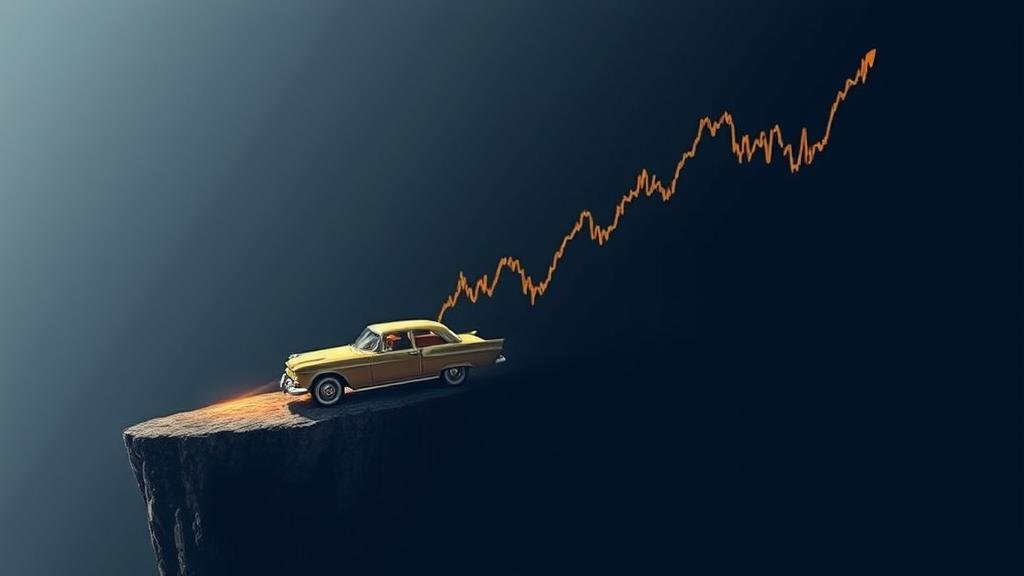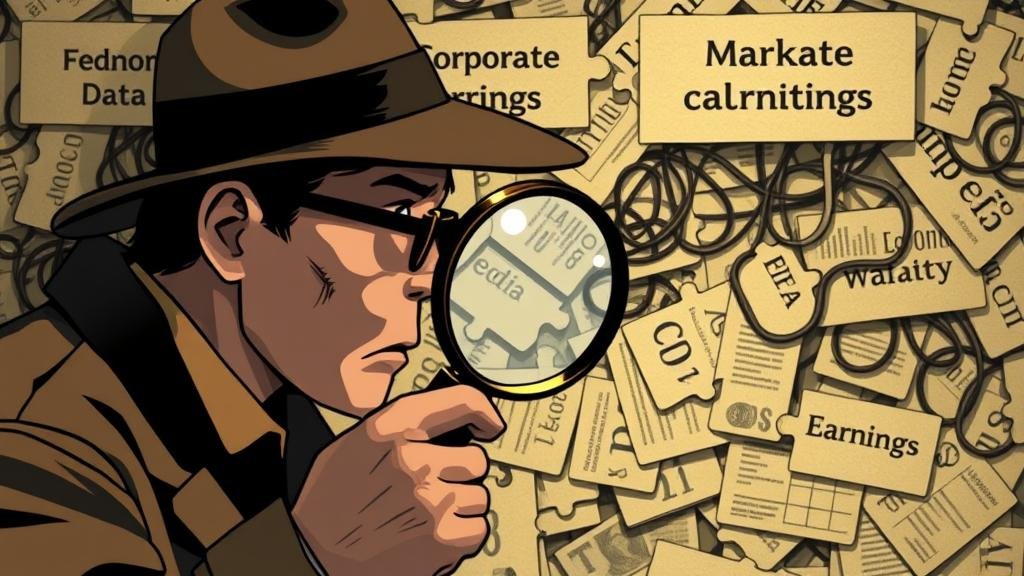The Nasdaq’s Wild Ride: What’s Fueling Market Volatility?
If the stock market had a personality, Thursday was a classic case of split personality. It started the day with the bubbly enthusiasm of a golden retriever, only to end it with the dramatic despair of a teenager whose phone just died. The Nasdaq Composite took investors on a roller coaster ride they didn’t sign up for, erasing a 2% gain to close deep in the red.
For those of us who consider “monitoring stock tickers” a legitimate hobby, the day began with a level of optimism usually reserved for the first day of a long weekend. Tech stocks were flying high, and investor sentiment was soaring. But then, sometime after a leisurely lunch, confidence decided to ghost the market, leaving a trail of sell orders in its wake. The selling pressure mounted faster than a toddler’s tantrum in a candy aisle.
So, what gives? Why is the stock market more prone to mood swings than a caffeinated squirrel? Let’s put on our detective hats and dive into this market madness.

Anatomy of a Market Reversal
To truly grasp the whiplash-inducing drama of Thursday, you need to understand this wasn’t a gentle decline. This was a “Thelma & Louise” moment for the market, as it drove right off a cliff.
The morning was a sea of green, with the tech-heavy Nasdaq leading a glorious charge. By midday, it was up over 2%, and you could almost hear a collective sigh of relief from investors globally. But then, with a dramatic plot twist, the sentiment shifted. The afternoon brought a selling frenzy that made Black Friday shoppers look like they were peacefully browsing. As Seeking Alpha aptly put it, the session was a “dramatic round trip,” which is a fancy way of saying it gave everyone a serious case of financial whiplash.
It wasn’t an isolated tech-stock tantrum, either. The Dow swung over 1,000 points from its high to its low. This wasn’t just one sector having a bad day; it was the entire market having a collective panic attack. The sheer speed of the sell-off screamed one thing: anxiety is bubbling just beneath the surface, ready to spill over at the slightest provocation.
So, what’s causing this market freak-out? Well, that’s what we’re here to figure out. And no, you can’t just skip to the end.

What’s Fueling the Fire? The Drivers of Stock Market Volatility
A market swing of this magnitude is rarely a solo act. It’s more like a potluck of problems, with each contributor bringing a different flavor of anxiety to the table.
1. The Federal Reserve’s Cryptic Messages
The market is like that overly attached friend who dissects every text message, and the Fed is the one sending the cryptic replies. Investors hang on every word from Fed officials, desperately searching for clues. Will they cut rates? Will they hold them steady? Can we get a hint, pretty please?
This creates a hair-trigger environment where the slightest whiff of bad news can send the market spiraling. The morning’s rally was built on the fragile hope of future rate cuts, a hope as sturdy as a house of cards in a hurricane. One slightly hawkish comment or a stubborn inflation report is all it takes to send everyone running for the exits, which is precisely what seems to have happened.
2. The Economic Data Conundrum
Let’s be honest, making sense of the current economic data is like trying to solve a Rubik’s Cube in the dark. One report suggests the economy is cooling down nicely (hooray, rate cuts!). The next points to persistent price pressures (boo, no rate cuts!).
When the market is caught in this crossfire of conflicting narratives, things get volatile. The Nasdaq’s initial 2% surge was a bet on a “perfect soft landing” fairytale. The subsequent collapse was the market’s brutal admission that its own conviction is weaker than a paper umbrella in a thunderstorm. Doubt, it turns out, is a highly contagious disease.
3. Corporate Earnings and a Dose of Reality
Here’s a hot take for you: stock prices eventually need to be justified by actual profits. It’s earnings season, and the tech sector, after years of being the cool kid at the party, is finally being asked to show its report card.
When a major company hints at slowing growth or a gloomy outlook, it doesn’t just impact that one stock; it sends a shiver down the spine of the entire sector. The afternoon sell-off felt like a much-needed reality check, a reminder that the sky-high valuations of some tech darlings might be built more on vibes than on solid fundamentals. It’s like discovering the star quarterback can’t actually throw a football. Disappointing, right?
The main takeaway? The market is on edge. And an edgy market is a skittish market.

A Flashback to April’s Jitters
If you’re getting a sense of déjà vu, you’re not wrong. Thursday’s whiplash was the biggest jolt of volatility since April, a time when the market was also in a tailspin over inflation and the Fed’s next move.
It’s like we’re watching a sequel: April Jitters 2: This Time It’s Even More Personal. The same villains—stubborn inflation and an unpredictable central bank—are back for another round. This wasn’t some random, out-of-the-blue event. It was an aftershock from the seismic shift away from an era of “free money.” Recognizing the pattern can help you keep a cool head. Most of the time.

What This Means for Your Investment Strategy
Okay, let’s take a collective deep breath. Before your eyes glaze over like a donut, let’s talk about what this means for you and your hard-earned money.
For the Long-Term Investor
Repeat after me: Do. Not. Panic. I see you, hovering your cursor over the “sell everything” button. Back away from the keyboard. Volatility is the price of admission to the “long-term wealth-building” club. A single chaotic day shouldn’t derail your entire investment strategy.
Instead, use this as an opportunity to:
- Review Your Holdings: Do you still believe in the long-term potential of the companies you own? If the answer is yes, then stay the course.
- Check Your Diversification: Is your portfolio a one-trick pony, heavily concentrated in just a few tech stocks? It might be time to spread your bets.
- Go Shopping (Strategically): When a great company’s stock gets hammered by market-wide fear, it can be a golden buying opportunity. Think of it as a fire sale on high-quality assets.
For the Active Trader
For you thrill-seekers out there, high volatility is where the action is. But Thursday was a stark reminder that trying to catch a falling knife is a dangerous game. Risk management is your best friend. Chasing a rally without a clear exit strategy is a surefire way to turn a fun day into a very expensive lesson.
And yes, this will be on the final exam.
The Takeaway: Navigating a Jumpy Market
At the end of the day, Thursday’s wild ride was a stress test for the market. And frankly, it failed spectacularly. The morning’s cheerful optimism was revealed to be a fragile facade, built on a foundation of hope rather than solid conviction.
The big-picture narrative—inflation, interest rates, and economic growth—is far from resolved. All eyes will remain glued to the Fed and every economic data point that’s released. Investors need to stay on their toes.
In a market this jumpy, knowledge isn’t just power—it’s your portfolio’s best defense. And maybe a good excuse to tune out the noise and “do some research.” You can thank us later.